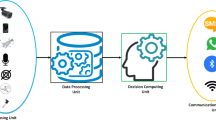Abstract
The use of Machine Learning to monitor old people is crucial in providing immediate assistance and potentially life-saving interventions. With the rapid innovation in the field of Artificial Intelligence and Computer Vision, fall detection has seen significant improvements in accuracy and efficiency. Traditionally, 2D Convolutional Neural Networks (CNN) have been the main focus in fall detection research. However, these approaches have several drawbacks, including that 2D CNNs are primarily designed for spatial feature extraction and may not fully capture the temporal dynamics across multiple frames. This is because, for 2D CNN, the video frames are averaged out on time dimension within a time window. This project aims to explore and validate the use of 3D Convolutional Neural Networks (CNN) for fall detection, specifically in care home settings. The proposed 3D CNN keeps all frames in the time dimension (without averaging out video frames) and therefore can capture spatiotemporal dynamics of fall events more effectively, potentially enhancing detection accuracy. Experiment results indicate that the proposed 3D CNN achieved a G-Means, the geometric mean of recall and specificity, of 96.92%, an improvement of 1.9% over the 2D CNN.
Access this chapter
Tax calculation will be finalised at checkout
Purchases are for personal use only
Similar content being viewed by others
References
NHS, Falls. https://www.nhs.uk/conditions/falls. Accessed 23 May 2024
Pakkari, J., et al.: Majority of hip fractures occur as a result of a fall and impact on the greater trochanter of the femur: a prospective controlled hip fracture study with 206 consecutive patients. Calcified Tissue Int. 65, 183–187 (1999)
NICE. Falls in older people: assessing risk and prevention, NICE Clinical guideline. https://www.nice.org.uk/guidace/cg161. Accessed 20 June 2024
Salimi, M., Machado, J.J.M., Tavares, J.M.M.S.: Using deep neural networks for human fall detection based on pose estimation. Sensors 22, 4544 (2022)
Espinosa, R., Ponce, H., Gutiérrez, S., Martínez-Villaseñor, L., Brieva, J., Moya-Albor, E.: A vision-based approach for fall detection using multiple cameras and convolutional neural networks: A case study using the UP-Fall detection dataset. Comput. Biol. Med. 115 (2019)
Yin, J., Yang, Q., Pan, J.J.: Sensor-based abnormal human-activity detection. IEEE Trans. Knowl. Data Eng. 20, 1082–1090 (2008)
Kangas, M., Konttila, A., Lindgren, P., Winblad, I., Jämsä, T.: Comparison of low-complexity fall detection algorithms for body attached accelerometers. Gait Posture 28, 285–291 (2008)
Harrou, F., Zerrouki, N., Sun, Y., Houacine, A.: Vision-based fall detection system for improving safety of elderly people. IEEE Instrum. Meas. Mag. 20, 49–55 (2017)
Lowry, C.A., Woodall, W.H., Champ, C.W., Rigdon, S.E.: A multivariate exponentially weighted moving average control chart. Technometrics 34, 46–53 (1992)
Kwolek, B., Kepski, M.: Improving fall detection by the use of depth sensor and accelerometer. Neurocomputing 168, 637–645 (2015)
Adhikari, K., Bouchachia, H., Nait-Charif, H.: Fall detection Dataset. https://falldataset.com. Accessed 22 June 2024
Rougier, C., Meunier, J., St-Arnaud, A., Rousseau, J.: Monocular 3D head tracking to detect falls of elderly people. IEEE Eng. Med. Biol. Soc. 6384–6387 (2006)
Martínez-Villaseñor, L., Ponce, H., Brieva, J., Moya-Elbor, E., Núñez-Martínez, J., Peñafort-Asturiano, C.: UP-Fall detection dataset: a multimodal approach. Sensors (Basel), 19 (2019)
Banos, O., Galvez, J.M., Damas, M.: Window size impact in human activity recognition. Sensors 14, 6474–6499 (2014)
Farnebäck, G.: Two-frame motion estimation based on polynomial expansion. In: Bigun, J., Gustavsson, T. (eds.) SCIA 2003. LNCS, vol. 2749, pp. 363–370. Springer, Cham (2003). https://doi.org/10.1007/3-540-45103-x_50
Tran, D., Bourdev, L., Fergus, R., Torresani, L., Paluri, M.: Learning spatiotemporal features with 3D convolutional networks. In: IEEE International Conference on Computer (ICCV), pp. 4489–4497 (2015)
Ji, S., Xu, W., Yang, M., Yu, K.: 3D Convolutional neural networks for human action recognition. IEEE Trans. Pattern Anal. Mach. Intell. 35, 221–231 (2013)
Carreira, J., Zisserman., A: Quo Vadis, action recognition? A new model and the kinetics dataset. In: IEEE Conference on Computer Vision and Pattern Recognition, pp. 4724–2733 (2017)
Mobasheri, B., Tabbakh, S.R.K., Forghani, Y: An approach for fall prediction based on kinematics of body key points using LSTM. Int. J. Environ. Res. Public Health 19(21) (2022)
Ramirez, H., Velastin, S.A., Aguayo, P., Fabregas, E., Farias, G: Human activity recognition by sequences of skeleton features. Sensors 22(11) (2022)
Acknowledgments
This work was funded by UK Research and Innovation, Knowledge Transfer Partnership project – partnership number: 13139.
Author information
Authors and Affiliations
Corresponding author
Editor information
Editors and Affiliations
Ethics declarations
The authors have no competing interests.
Rights and permissions
Copyright information
© 2025 The Author(s), under exclusive license to Springer Nature Switzerland AG
About this paper
Cite this paper
Toh, S.M., Helian, N., Pasipamire, K., Sun, Y., Pasipamire, T. (2025). Vision-Based Human Fall Detection Using 3D Neural Networks. In: Bramer, M., Stahl, F. (eds) Artificial Intelligence XLI. SGAI 2024. Lecture Notes in Computer Science(), vol 15447. Springer, Cham. https://doi.org/10.1007/978-3-031-77918-3_4
Download citation
DOI: https://doi.org/10.1007/978-3-031-77918-3_4
Published:
Publisher Name: Springer, Cham
Print ISBN: 978-3-031-77917-6
Online ISBN: 978-3-031-77918-3
eBook Packages: Computer ScienceComputer Science (R0)




